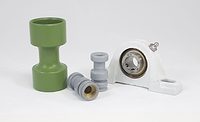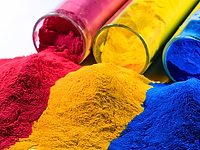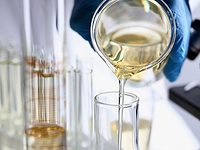Solving Two Key Powder Coatings Challenges with Pelletized Aluminum

In addition to their durability and ease of application, powder coatings offer important environmental benefits to the paint industry. No solvents are used when sprayed and there are minimal volatile organic compounds (VOCs) released. Any material that does not adhere to the substrate after spraying can be collected and used again, resulting in very little waste.
Since a solvent-free effect pigment powder must be used in powder coatings, a large release of dust is caused as it is being processed and handled. For metallic pigments, the dust not only poses an inhalation hazard, but is potentially explosive if clouds of dust are generated. This risk increases with the fineness of the pigments and requires special safety precautions to mitigate.
It is widely known across the powder coatings industry that aluminum pigments need to be handled with care, as the coupled effect of small size and reactivity mean that aluminum pigments have a low minimum ignition energy (MIE) and high kST value.
The MIE and kST are measures of how much energy is required to ignite a powder or dust, and the strength of that explosion, respectively. It is typically a function of the particle size of the dust. Dry, powdered aluminum pigments, which can have a d50 as low as 5 µm, have a low MIE (<5 mJ) and high kST (>300 bar m/s).1 These hazards increase as the size of the aluminum pigments decrease.
Aluminum pastes, powders and pellets fall into specific categories for transportation and storage in each region of the world, depending on local regulations. Because of their reactive nature, aluminum powders are classified in the United States by the Department of Homeland Security as “Chemicals of Interest.” As such, there are specific guidelines to ensure against their misuse, depending on quantities.
There are also specific guidelines for transportation set by the various agencies in North America and Europe. Aluminum powders can be classified as hazardous materials by the U.S. Department of Transportation (DOT), or dangerous goods under the European Agreements Concerning International Carriage of Dangerous Goods by Road and Rail (ADR/RID). In China, Decree 591 sets guidelines specifying certified warehouses for storage of aluminum powders.
The Challenge of Aluminum Pigments’ Shape
Aluminum pigments have a bright, silvery to grey metallic appearance that is defined by their brightness (L*) values and gloss. Platelet-shaped aluminum pigments have excellent hiding power when compared to spherical pigments. Because of their shape, they are very susceptible to bending and breakage under high-shear mixing, like extrusion, and are typically incorporated into powder coatings in subsequent processing steps.
Metallic pigments can be dry blended into a powder coating. However, because this only makes a physical mixture between two powders, this can cause issues during application of the powder coating, where the pigment and coating particles separate due to electrostatically charging differences. This causes the overspray to be unusable due to inconsistent color.
A process known as bonding is often used to incorporate metallic pigments into a powder coating to mitigate these issues. During bonding, the powder coating is heated to just above its softening point and combined with effect pigments under moderate shear, causing the pigments to adhere to the surface of the powder coating. Such a process provides sprayed parts that have excellent pigment orientation, resulting in the best appearance for powder coated articles.
Solving the Dusting Issue
In other industries where aluminum needs are used in a solvent-free form, such as a plastic masterbatch, aluminum is often combined with a resin, extruded and dried to make a pelletized product. The pellet mitigates dust, increasing the MIE and decreasing the likelihood of an explosion.
If this approach could be applied to an aluminum pigment intended for use in powder coatings, it could provide a benefit to converters who need to work with fine aluminum pigments. For such a preparation to work, however, the pellet would need to be easily friable and dispersible in a powder coating while the compounding resin would need to be widely compatible with many different powder coating types.
A pelletized aluminum preparation for powder coatings has been developed by Sun Chemical that combines a fine (d50 = 9 µm), leafing aluminum pigment with a polyester resin. These products have an aluminum content of 85%, with the remaining fraction being the resin, which allows formulators to use these products without having a dramatic impact on the resin content of the base paint. The pellet is highly friable and can be incorporated into most polyester-based powder coatings by either high-shear dry blending or bonding to give an appearance that is like a bonded aluminum powder of equivalent size and composition.
The pelletized aluminum pigments are made using a fine, leafing corn flake pigment with a D50 particle size distribution of 9 microns. They are composed of approximately 85% aluminum flake and 15% of a polyester resin. The pellets are dry and approximately 5 mm in diameter. A photo of the pellets can be seen in Figure 1.

For high-shear dry blending, the pellets are added to a powder coating base at 1.25% total metal loading and mixed at 50% of the speed/time for a typical bonding step.
These samples were compared to a dry blended leafing aluminum (Benda-Lutz Leafing 2081) that was incorporated under the same conditions and at the same loading. Bonding of the pelletized and unpelletized aluminum was carried out at 1% total metal loading using standard bonding protocols. The pigmented powder coating bases were applied to stainless steel panels and cured according to the parameters of the base.
The 60º gloss, brightness (L*) (L*15, measured at 45º incident light and 15º aspecular) and the flop index (FI), which is determined by Equation 1:

Where L*45 and L*110 are brightness measured at 45º incident light and 45º and 110º aspecular reflection angles, respectively. All color measurements were performed on an X-Rite MA-98 multi-angle spectrophotometer. Gloss measurements were performed on an Elcometer 6015 Novo-Gloss IQ Glossmeter.
Table 1 shows the minimum ignition energy (MIE) for a fine aluminum pigment and a 2 mm diameter pellet made using the same. Modification of the pigment’s physical form is one of the few ways to raise the MIE, as it allows for a decrease in dust concentration and significantly larger suspended particles. In standard MIE testing, only particles less than 75 µm are tested. The pelletized product increased the MIE of the fine aluminum powder by two orders of magnitude, which is a substantial change. Further increases in the pellet’s size are expected to yield a larger MIE value.
This data is important as it affects the transportation and storage requirements for different forms of aluminum pigments. Pellets designed for powder coatings are exempt and not regulated as dangerous goods per the applicable hazardous material transportation regulations. This can significantly simplify the supply chain and logistics for using pellets as compared to aluminum powders.
Achieving Industry Bonding Standards
It is important for the new pelletized aluminum pigments to meet industry standards currently used through bonding.
Figure 2 shows the L*15 (a, d, & g), flop index (b, e, & h) and brightness (c, f, & i) of the pelletized aluminum and the leafing aluminum control (2081) after being incorporated into either a triglycidyl isocyanurate (TGIC)-cured (a-c) or a b-hydroxyalkyl-amide (HAA)-cured (d-f) polyester powder coating.

Figure 2g-i shows the results for the aluminum pellet in a polyurethane-type of powder coating. In addition to a comparison of the different forms of aluminum, Figure 2 also shows the different appearances that can be achieved depending on the incorporation method used, whether it is high-shear dry blending (red and blue bars) or bonding (green and yellow bars).
Focusing on the TGIC examples first (Figure 2a-c) reveals that the pelletized aluminum pigment has a similar brightness to the 2081 in this system. More surprising is that, in this system, the dry blended and bonded pellets are superior in flop compared to blended or bonded, unpelletized aluminum. The dry blended and bonded pellets have similar gloss, and both are less glossy (Figure 2c) than the bonded aluminum. In all cases, the dry blended leafing pigment is the most inferior in flop and gloss for the TGIC-cured polyester.
This data shows that the pelletized aluminum can be incorporated by two different methods to give a bright metallic finish that is comparable to the bonded, loose aluminum. Moreover, the color travel data suggest that the pellets have a better overall orientation in this powder coating compared to unpelletized pigments. Indeed, the inclusion of the resin may help orient the aluminum into a flat configuration when the powder coating is cured.
The gloss is best for the bonded aluminum, with the bonded, pelletized aluminum coming in second. This is not particularly surprising considering that gloss in powder coatings can be driven by the resins in the system. Depending on the resin compatibility, this could result in a smoother finish that is aided by the superior orientation of the aluminum, increasing the gloss.
If this is the case, then it is not unreasonable to expect that the pelletized aluminum may exhibit different types of behavior in different resin systems and classes. The dry blended aluminum has the worst gloss, even when compared to the dry blended pellet. This suggests that the pelletized aluminum may be better wetted out by the resin in the powder coating, which helps to drive its alignment.
The difference in incorporation behavior is demonstrated for the HAA-cured polyester shown in Figure 2d-f. In this instance, the dry blended pellet has the higher L*15 and flop index, while the bonded pellet has the highest gloss. The pelletized pigments outperform the pigment powders, regardless of their incorporation method. This could be due to a similar phenomenon above, where the pellet resin positively affects the interaction between the aluminum and the powder coating matrix, acting almost like a dispersant.
Finally, Figure 2g-i shows the incorporation behavior in a polyurethane-based powder coating. In this instance, the pelletized aluminum is optically superior to the unpelletized aluminum in every case, even when comparing a dry blended pellet to the bonded, unpelletized pigment.
While this data shows that the pelletized aluminums are compatible with different powder coating systems, it is likely that formulators would need to optimize performance of these pellets for a particular powder coating system.
Conclusion
While aluminum flakes are widely used in all powder coating types because of their brightness, opacity, durability and formulation flexibility, they require specific handling and storage techniques to maximize their appearance and for safe usage. Aluminum pellets are an alternative delivery form that can be incorporated using existing methods of dry blending or bonding to give equal or better appearance in a variety of paint chemistries. Pellets lower dusting and offer significantly higher MIE while maintaining the versatility and appearance benefits of aluminum powder, making them an attractive option in powder paint manufacturing.
To learn more, email michael.venturini@sunchemical.com.
References
1. OSHA 3371-08 2009 “Hazard Communication Guidance of Combustible Dusts”
Looking for a reprint of this article?
From high-res PDFs to custom plaques, order your copy today!









